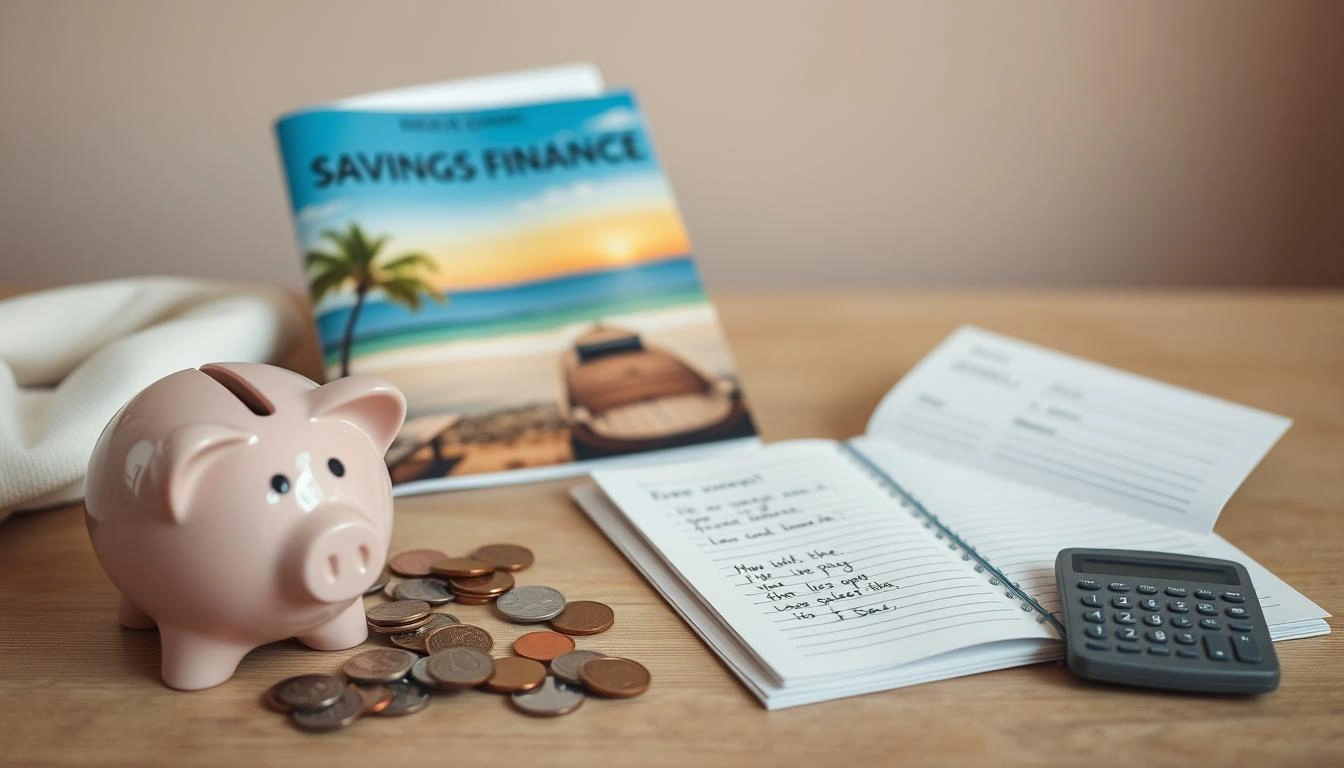Every traveler dreams of the perfect getaway a chance to escape the daily grind and create unforgettable memories. But planning a vacation is more than just choosing a destination. It’s about turning your financial goals into real travel experiences. Learning how to save for a vacation makes those dream trips possible, without the stress of debt.
Saving for a vacation needs careful planning and financial discipline. When you plan with purpose, you can make your travel dreams come true. This way, you don’t have to sacrifice your financial stability.
Whether you want a beach vacation, an adventure in Europe, or a road trip across the country, saving is key. Understanding how to save can turn wishes into reality. Your journey begins with clear goals, smart plans, and a commitment to your dreams.
Key Takeaways
- Create a realistic vacation savings timeline
- Set specific financial goals for your trip
- Develop a dedicated savings strategy
- Cut unnecessary expenses to boost travel funds
- Explore additional income sources for travel
Understanding the Importance of Vacation Planning
Planning a vacation is more than picking a place to go. It’s about making a plan that includes money and realistic goals. With careful budgeting and smart financial planning, your dream trip can become a real adventure.
Benefits of Proper Vacation Financial Planning
Spending time on vacation planning can make your trip better. Good financial planning brings many benefits:
- Reduces financial stress during your trip
- Prevents unexpected expenses
- Allows for more enjoyable travel experiences
- Helps create a sustainable travel budget
Setting Realistic Travel Expectations
Setting realistic financial goals for your vacation means knowing your budget and travel costs. Realistic planning prevents disappointment and overspending. Make a detailed budget that includes:
- Transportation costs
- Accommodation expenses
- Daily spending money
- Emergency fund allocation
Why Dedicated Travel Savings Matter
Having a special savings account for travel keeps your vacation money separate. This helps you stay on track and be financially disciplined.
| Savings Strategy | Monthly Impact | Annual Potential |
| Automatic Transfers | $50-$200 | $600-$2,400 |
| Expense Cutting | $100-$300 | $1,200-$3,600 |
| Side Income | $200-$500 | $2,400-$6,000 |
By learning about vacation planning and using smart budgeting tips, you can make your travel dreams come true.
Setting Clear Vacation Goals and Budget Targets

Starting your dream vacation planning means setting clear financial goals. First, decide what you want to achieve. Pick a specific destination and learn about its costs to make your dreams real.
When planning your vacation budget, keep these points in mind:
- Research destination costs thoroughly
- Estimate expenses for transportation
- Calculate accommodation prices
- Factor in daily meal and activity expenses
- Create a comprehensive budgeting strategy
Breaking down your goals into smaller steps makes saving easier. Smart travelers plan well to avoid money surprises. Start by looking up costs for your dream place. Then, make a savings plan that works with your budget.
Here are some budgeting tips for your vacation:
- Determine total trip cost
- Divide total cost by months until travel
- Set automatic monthly savings transfers
- Track progress using digital budget apps
- Adjust savings strategy as needed
Remember, saving for travel is about smart planning, not cutting back too much. It’s about making your vacation dreams come true.
How to Save for a Vacation: Essential Steps to Success
To make your dream vacation come true, you need a solid plan and smart savings. It’s not about giving up everything, but finding a way to save that works for you.
Start by breaking down your savings goals into smaller steps. The goal is to create a plan that matches your budget and keeps your dreams alive.
Creating a Realistic Timeline
Begin your savings journey with a clear timeline. Think about these important points:
- Determine your desired travel dates
- Assess your current income and expenses
- Calculate the total estimated trip cost
- Set a flexible but committed savings deadline
Breaking Down Savings into Monthly Goals
Turn your vacation budget into bite-sized monthly targets. For example, if your trip costs $3,000 and you have 12 months, aim to save $250 each month.
Tracking Progress Effectively
Keeping track of your expenses is key to saving for travel. Use digital tools and apps to monitor your savings:
- Budgeting apps like Mint or YNAB
- Spreadsheet tracking systems
- Dedicated vacation savings bank accounts
- Regular financial check-ins
Your savings plan should motivate you, not feel like a burden. Celebrate your small winsand stay adaptable as your finances change.
Creating a Dedicated Vacation Savings Account
Planning your dream vacation needs smart money management. A dedicated vacation savings account is a great tool. It helps you reach your financial goals and make your travel dreams come true.
Opening a separate account for travel savings helps a lot. It keeps your vacation money separate from your daily spending. This has many benefits:
- Prevents accidental spending of travel money
- Provides visual motivation as your balance grows
- Helps track progress toward your travel goal
- Separates vacation funds from emergency savings
When picking the right savings account, consider these factors:
- Interest Rates: Choose high-yield savings accounts that earn more
- Minimal or no monthly fees
- Easy online access and tracking
- Potential sign-up bonuses or rewards
Digital banks and credit unions offer special travel savings accounts. They have competitive rates. Some banks even have automatic savings tools to help you reach your goals faster. By setting up automatic monthly transfers, you’ll grow your vacation fund withouteffort.
See your vacation savings account as a promise to yourself. Watching your travel fund grow is very motivating. It makes your dream trip feel closer with each deposit.
Smart Budgeting Strategies for Travel

Planning your dream vacation needs more than just saving. Good budgeting tips can turn your travel dreams into real plans. Learning to track expenses and manage money wisely lets you explore new places with confidence.
Good travel planning begins with tracking all your expenses. Breaking down costs helps you make a solid financial plan for your trip.
Calculating Total Trip Expenses
To make a solid budget, think about these main costs:
- Transportation costs (flights, train, rental car)
- Accommodation expenses
- Daily meal and dining budgets
- Activity and entertainment fees
- Miscellaneous expenses
Building an Emergency Travel Fund
An emergency fund is key for unexpected costs. Aim to save 10-15% of your total trip budget for things like medical needs, travel delays, or last-minute adventures.
| Budget Category | Recommended Allocation |
| Transportation | 35-40% |
| Accommodation | 25-30% |
| Food and Dining | 15-20% |
| Activities | 10-15% |
| Emergency Fund | 10-15% |
Managing Daily Expenses While Saving
Smart money management lets you save without feeling limited. Look for ways to cut daily spending, like:
- Reducing dining out frequency
- Canceling unnecessary subscriptions
- Finding free entertainment options
- Using cashback credit cards
By using these budgeting tips and tracking expenses well, you’ll be closer to making your travel dreams come true.
Automating Your Vacation Savings Plan

Turning your travel savings into a smooth process needs smart money management. Automating your vacation fund is a top financial trick for making dream trips real. By setting up automatic transfers, you build your travel budget without needing to do it manually every time.
Creating an automated savings plan involves several key steps:
- Choose a dedicated travel savings account with no monthly fees
- Determine a realistic monthly contribution amount
- Set up automatic transfers from your checking account
- Select a transfer date right after your paycheck arrives
When savings happen automatically, reaching your financial goals is easier. Banks and digital apps offer great tools to make this process smoother. Apps like Digit or Qapital can round up purchases and automatically transfer spare change into your vacation fund.
The psychology behind automated savings is strong. By treating your travel savings like a bill, you avoid skipping monthly contributions. Most people don’t even notice the money being taken out, making savings seem easy.
Pro tip: Start small and gradually increase your automated transfer amount. Even $50 monthly can grow a big travel fund over time. Your future self will be grateful when thatdream vacation becomes a reality!
Cutting Unnecessary Expenses to Boost Savings
Changing your spending habits can really help you save for vacations. Frugal living is notabout giving up things you love. It’s about making choices that help you reach your travel goals. By using smart budgeting tips, you can save money that would otherwise be spent on things you don’t need.
Finding ways to cut costs starts with tracking your expenses. Begin by looking at your monthly spending. This will help you find ways to save money.
Identifying Areas for Cost Reduction
- Review subscription services you rarely use
- Evaluate dining out and entertainment expenses
- Check recurring monthly bills for potential savings
- Analyze impulse purchasing habits
Smart Money-Saving Substitutions
There are many ways to save money without feeling like you’re missing out. Here are some budget-friendly ideas:
| Expense Category | Current Spending | Money-Saving Alternative | Potential Monthly Savings |
| Coffee | Daily cafe purchases | Home-brewed coffee | $80-$120 |
| Entertainment | Cable TV | Streaming services | $50-$70 |
| Groceries | Name-brand products | Generic alternatives | $40-$60 |
Monthly Expense Tracking Methods
Keeping track of your expenses is key to saving money. Digital tools and old-school methods can help you stay on track:
- Use budgeting apps like Mint or YNAB
- Create spreadsheet tracking documents
- Implement the envelope budgeting system
- Set up automatic expense categorization
By sticking to these budgeting tips and tracking your expenses, you’ll see your vacation fund grow fast. Even small changes can add up to big savings. This will help you make your travel dreams a reality.
Finding Additional Income Sources for Travel
To boost your vacation fund, you need creative ways to manage money. Side hustles canturn your dreams of travel into real plans. Look for different ways to earn money that won’t disrupt your daily life.
Digital platforms are full of chances to make extra cash. Here are some side hustles to consider:
- Freelance writing or graphic design on platforms like Upwork
- Tutoring online through educational websites
- Selling handmade crafts on Etsy
- Driving for rideshare services
- Delivering food using apps like DoorDash
Use your current skills to earn more. Think about turning hobbies like photography, webdesign, or language translation into money-making ventures. Many people make good side income by using their existing skills.
Decluttering can also help your travel fund. Sell things you no longer need on sites like eBay or Facebook Marketplace. Items like electronics, furniture, and collectibles can bring in cash to help fund your trips.
Make sure to put every extra dollar into your travel savings. View side hustle income as your vacation money. This way, you’ll reach your travel goals faster and more easily.
Maximizing Travel Rewards and Loyalty Programs
Smart travelers turn vacation planning into an exciting adventure. They save money by using smart reward programs. It’s not just about spending less; it’s about getting more value from every dollar.
Credit card rewards offer a chance to earn big travel benefits while keeping your budgetin check. Not all credit cards are the same. Choosing the right one can save you a lot ontravel costs.
Credit Card Point Strategies
When picking a travel rewards credit card, keep these tips in mind:
- Look for cards with sign-up bonuses offering 50,000+ points
- Select cards matching your spending habits
- Understand point redemption values
- Track expiration dates for accumulated points
Best Travel Reward Programs
Some top travel reward programs offer great value:
- Chase Sapphire Preferred: Flexible points redemption
- American Express Platinum: Luxury travel perks
- Capital One Venture: Simple miles earning structure
Timing Your Bookings for Maximum Benefits
Booking strategically can boost your travel savings. Look into peak and off-peak seasons. Compare point values and stay flexible with travel dates to get the most rewards.
Remember, using credit cards wisely is key. Always pay off balances fully and avoid debt to enjoy travel rewards.
Preparing for Last-Minute Travel Expenses
Unexpected costs can ruin your travel savings plan. Smart budgeting tips help you get ready for those last-minute expenses. Having a financial buffer means you’re set for spontaneous adventures or unexpected challenges.
When planning your travel savings, think about setting aside an emergency fund for unplanned expenses. Experts say to save 10-15% of your total travel budget for these surprise costs. Keeping track of your expenses is key to managing these financial surprises.
- Create a flexible budget buffer for unexpected expenses
- Research typical additional costs for your destination
- Keep an emergency credit card with a reasonable limit
- Download budget tracking apps for real-time expense monitoring
Different places need different financial plans. A weekend city trip might need less emergency funding than an international trip. Think about these potential last-minute expenses:
| Expense Category | Potential Cost Range |
| Medical Emergencies | $100 – $500 |
| Transportation Backup | $50 – $200 |
| Unexpected Activities | $75 – $250 |
By using these budgeting tips and keeping a solid expense tracking plan, you’ll travel with confidence. Your vacation savings plan gets stronger when you’re ready for financial surprises.
Conclusion
Saving for a vacation is possible. You can make your travel dreams come true with the right plan. Start by breaking down your savings into smaller, doable steps.
Learning to save for a vacation begins with commitment and wise money choices. Opena special savings account and look for ways to earn more. Every little bit helps, and soon you’ll have enough for your trip.
Use budgeting, rewards, and smart spending to grow your savings. It’s not just about cutting back it’s about making choices that help you reach your travel goals. Begin using these tips now, and watch your savings grow.
Being patient and persistent is key to saving for a vacation. Stay focused on your goals and use the strategies we’ve shared. Before you know it, you’ll be ready for an amazing trip. Your dream vacation is closer than you think, one smart step at a time.


1 thought on “How to Save for a Vacation: Smart Strategies for Your Dream Trip”
Comments are closed.